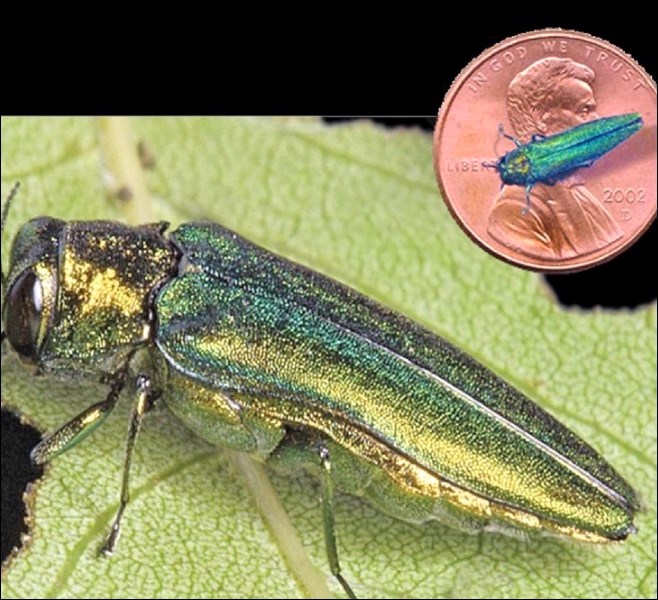Recent news from City Council meetings, being reported in the local media, regarding emerald ash borer has indicated a somewhat different picture than the actual reality of the pest in the province.
Facts
Emerald Ash Borer is an invasive insect from Asia. Being from Asia, it has no natural enemies here in our ecosystem, no natural controls.
The emerald ash borer (EAB) is a small metallic green beetle, about a centimetre long. In Asia, the beetle attacks weakened and stressed ash trees, but over here it kills healthy ash trees.
The larva chews just under the bark interrupting sap flow and killing the portion of the tree above where the larva feeds.
It is likely that it arrived here imported as eggs or larva in wooden crates used for shipping goods from Asia.
Emerald ash borer is now largely spread by people transporting infested firewood or wood products.
EAB was discovered in Winnipeg in the fall of 2017 many years ahead of the insect’s natural migration ability.
EAB will infest and destroy all ash trees from the genus Fraxinus which means green ash, black ash, white ash, Manchurian ash. It will not infest Mountain Ash. Mountain ash is from a different genus. It will not infest any other trees other than ash.
In prairie urban forests, ash trees can make up as much as 20-30 per cent of the total tree population in a community. It is something to be concerned about.
They are not dealing with emerald ash borer in Regina as was recently reported. I talked to the Forestry Department in Regina to verify this.
In fact, emerald ash borer has not been discovered anywhere in Saskatchewan. I called the CFIA (the Federal Government agency responsible for invasive pests) in Saskatoon to verify this.
A report from earlier in the winter indicated that the City of Winnipeg had already removed 30 per cent of their ash tree population due to the EAB infestation. When I called the City Forester there, she indicated to me that that was not the fact and, to date, they had only removed three trees infested with EAB.
So that being said …
There is no immediate threat. But, that doesn’t mean we can be complacent.
The city is wise to become part of the monitoring program that will indicate the presence of the EAB. This will improve their chances at getting the jump on the pest early on.
Prevention and Management
The province of Saskatchewan has declared emerald ash borer a pest in an effort to prevent infested wood, wood products or nursery trees from entering the province.
CFIA and the province and now some of the larger municipalities including North Battleford are part of the provincial EAB monitoring program.
This involves placement of sticky traps around the community that have scented lures on them to attract emerald ash borers if they are around. Although they are called traps they do not do anything to control the population numbers of the insect. They are only there to indicate the presence of the pest. The traps will be collected later in the season and sent to an entomology lab where they will determine if EAB is present or not. Early detection is crucial.
Do not transport firewood from province to province or from campground to campground. If its ash firewood from an infested area, it could be full of EAB larva or eggs. Burn it where you buy it. It is now against the law in Saskatchewan to transport ash firewood or wood products from an infested area into our province.
The key to slowing the destruction of the ash trees due to the EAB is educating the public, early detection of the presence of the EAB and immediate removal of any and all infested trees.
Be assured that there has been no EAB detected in the province to date, but at the same time, if you own ash trees, be aware, be vigilant and when it comes to firewood, burn it where you buy it.




